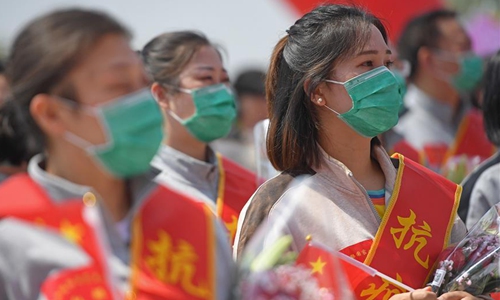China rectifies death toll based on facts, unaffected by Western noise: Global Times editorial
Source:Global Times Published: 2020/4/17 14:18:40

Members of the medical assistance team supporting the virus-hit Wuhan in Hubei Province attend the welcoming ceremony at the First Affiliated Hospital of Nanchang University in Nanchang, east China's Jiangxi Province, April 15, 2020. The 141 members of the medical assistance team reunited with their families on Wednesday after 14-day quarantine.Photo:Xinhua
The city of Wuhan in Central China's Hubei Province rectified its COVID-19 death toll to 3,869 on Friday, an increase of 1,290 from the previous figure, after the local government altered its counting method. The revision also means that the death toll in the Chinese mainland increased from 3,342 to 4,632.This is a responsible correction in accordance with laws and regulations. It is also a consolation to the people who died in this epidemic and their families, as well as an explanation to the whole of Chinese society.
Recently, the public opinion sphere alleged the concealment of death tolls by the authorities, and some in the West spared no effort in hyping this speculation. Wuhan was not affected by these claims but carried out its reviews and corrections based on infectious disease prevention and control laws. Adhering to the facts is top priority.
The strict review and correction of the death toll means there is no room for deliberate concealment. Speculation that China falsified the death toll from the coronavirus is far from truth. Some people thought so because they did not understand the work procedures used during China's virus fight, while others just adopted a malicious attitude toward China.
At the early stage of Wuhan's outbreak, the number of infected patients kept growing, and the medical system was overwhelmed. Chaos easily led to mistakes and failures in reporting at the grassroots level. There was a lack of ability in terms of nucleic acid testing and treatment. The confirmation of the cause of death in each case and the strict supervision of death tolls were set up gradually.
At the grassroots level, there was discussion as to whether some patients died of the coronavirus-driven pneumonia or not at the initial stage of the outbreak. People should have expected certain miscalculations regarding the death toll.
It can also be inferred that the death tolls in most countries hit hard by the pandemic won't be very accurate. Many COVID-19 patients will die of complications. It's likely that data collection will be chaotic, since the cause of death in each case could be made wrong.
This is not a political problem, but rather a technical issue concerning the organization and management of the disease-fighting effort. But some people have questioned the number of COVID-19 deaths in China for political reasons and politicized the data. That is how it has become a sensitive issue.
As the first country that launched a nationwide mobilization against the novel coronavirus, even a relatively low death toll would be viewed as a big number. People in Wuhan bore huge pain and losses at the peak of the epidemic, which numbers alone don't describe. A statistical system was eventually set up, but underreporting the death toll would benefit nobody. The political and legal risks of such action would be unbearable.
China is not a country where one can fabricate data in complete disregard of the law. Everybody knows it is a crime to maliciously fabricate data that concerns the whole nation. Doing so also has to involve the coordination of multiple departments and people, but such a scheme can be easily exposed. It can be said that ill-intended data manipulation can't occur in today's China.
China released calibrated data on Friday. It is hoped the veracity of the data can put all controversy surrounding it to rest. The issue again reminds us that any official data released by China can be politically scrutinized. Any technical error could be seen as a political sin. All official agencies of China must be extremely careful in their data releases. This is the most reliable approach.
Posted in: EDITORIAL